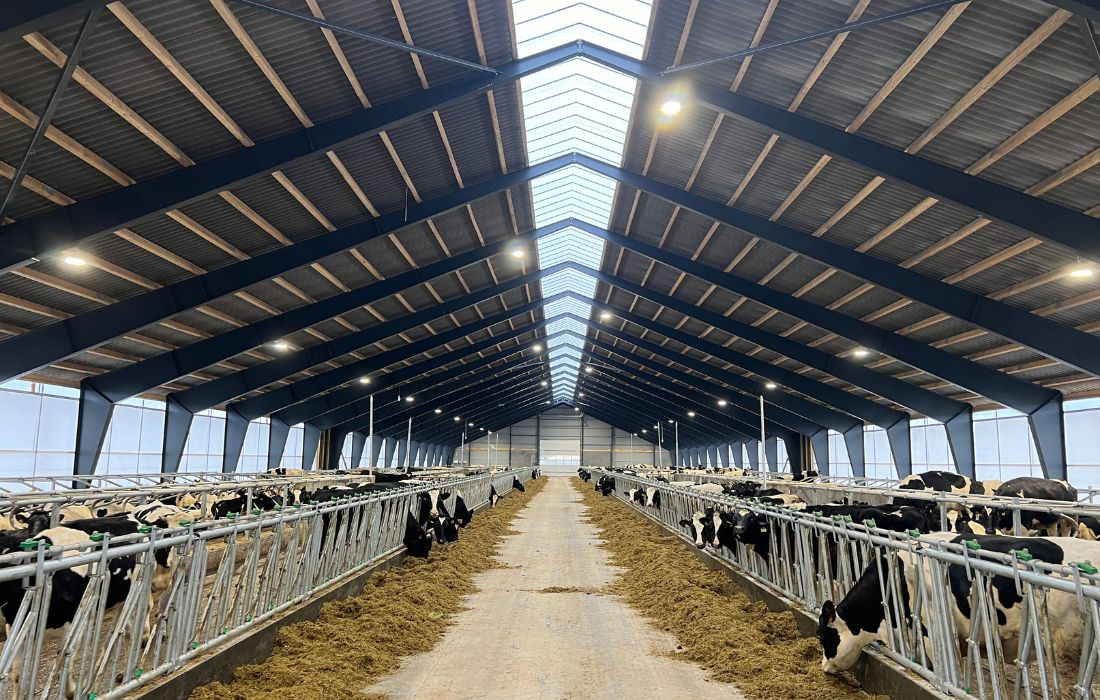Increase Milk Production with LED Lighting – Proven Effect among Danish Dairy Farmers
- 11 Jun, 2025
- News and Press Coverage , Blog

Increased Milk Production with LED Lighting – Lighting That Boosts the Bottom Line
In modern dairy farming, everything revolves around optimizing conditions around the cow – and lighting plays a much bigger role than many might think. The right lighting can significantly enhance the welfare and productivity of dairy cows. Several Danish farmers have already switched from conventional lighting to LED solutions with fully automated light control systems developed specifically for barn environments – and the results speak for themselves: higher yields, improved animal welfare, and reduced energy consumption.
Documented Progress Among Danish Dairy Producers
Years of experience from Danish dairy farms show that LED lighting and control systems from RN Solutions can increase ECM (energy-corrected milk) by as much as 6–8%. The solution provides a minimum of 200 lux for 16–18 hours a day, combined with automatic daylight regulation that adjusts artificial lighting to match natural light levels, optimizing both energy use and CO₂ emissions.
While higher milk yields naturally lead to a slight increase in feed consumption, experience clearly shows that the additional feed cost is far outweighed by the economic benefits. Increased milk production per cow leads to significantly improved profitability, often resulting in payback periods as short as 3–4 months.
Danish ECM – and the Potential for More
In Denmark, the average ECM ranges from 10,500 to 11,500 kg per cow annually, depending on breed and management. Through breeding, feeding, and general optimization, an annual increase of 1–3%* is typically achieved. But when lighting is used as a strategic factor, the potential grows dramatically.
Several studies – along with real-world experience from Danish farms – show that LED lighting and control systems can boost milk yields by 6–8%, without disproportionately increasing feed costs.
Lighting’s Impact on Hormonal Balance and Well-Being
When cows are exposed to a controlled lighting environment with 16–18 hours of light and 6–8 hours of darkness, their hormonal balance is positively influenced. Reproductive performance improves and remains stable year-round. Production of IGF-1 (Insulin-like Growth Factor), which promotes milk production, increases significantly. At the same time, feed intake typically improves by 6–10% as cows become more active and thrive in a properly lit environment.
More activity and more feed mean more raw material for milk production – and with the right feed composition, this directly translates to higher yields.
LED Lighting Designed for Animal Welfare and Efficiency
RN Solutions’ LED lighting delivers stable, flicker-free illumination with high brightness and color temperatures tailored to cows’ visual perception and behavior. The fixtures are purpose-built for the harsh barn environment – resistant to moisture, dust, and ammonia, with minimal heat generation and a typical lifespan of up to 50,000 hours.
The system is programmable to simulate natural day-night cycles (sunrise and sunset), and automatic daylight regulation ensures that no more energy is used than necessary.
A Concrete Example
For example, an increase of just 6–8% in ECM corresponds to 600–800 kg of additional milk per cow annually. In a herd of 100 cows, that equates to an extra 60,000–80,000 liters of milk per year. Even if feed intake rises slightly alongside production, the value of the extra milk far exceeds the additional costs – which is why the investment typically pays for itself within just a few months.
LED Is More Than Light – It’s Management
When LED lighting is integrated as an active part of daily operations, it becomes much more than a basic utility. It becomes a management tool that impacts production performance, animal welfare, and the bottom line.
That’s why every barn optimization investment should also look upwards – toward the light.
*Source: SEGES and Danish Agriculture







